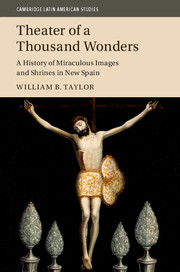Book contents
- Frontmatter
- Dedication
- Contents
- List of Figures
- List of Maps
- List of Tables
- Preface and Acknowledgments
- Archive Abbreviations
- Introduction
- Part I Bearings: Historical Patterns and Places of Image Shrines
- 1 Formative Developments, 1520s–1720s
- 2 Growth, Other Changes, and Continuities in the Late Colonial Period
- 3 Miraculous Images of Christ and the Virgin Mary
- 4 Advocations of the Virgin Mary in the Colonial Period
- Part II Soundings: Divine Presence, Place, and the Power of Things
- Conclusion
- Appendix 1 Colonial Image Shrines
- Appendix 2 When Shrines Began
- Appendix 3 Other Saints
- Index
3 - Miraculous Images of Christ and the Virgin Mary
from Part I - Bearings: Historical Patterns and Places of Image Shrines
Published online by Cambridge University Press: 05 September 2016
- Frontmatter
- Dedication
- Contents
- List of Figures
- List of Maps
- List of Tables
- Preface and Acknowledgments
- Archive Abbreviations
- Introduction
- Part I Bearings: Historical Patterns and Places of Image Shrines
- 1 Formative Developments, 1520s–1720s
- 2 Growth, Other Changes, and Continuities in the Late Colonial Period
- 3 Miraculous Images of Christ and the Virgin Mary
- 4 Advocations of the Virgin Mary in the Colonial Period
- Part II Soundings: Divine Presence, Place, and the Power of Things
- Conclusion
- Appendix 1 Colonial Image Shrines
- Appendix 2 When Shrines Began
- Appendix 3 Other Saints
- Index
Summary
Figures of Christ and the Virgin Mary, renowned for miracles and showered with votive offerings and heartfelt thanks, account for nearly all shrine images in New Spain. This chapter surveys these celebrated figures of Christ and Mary in a more focused way than do the first two chapters, as both a subject in its own right and another context for the themes developed in Part II, where particular shrines and images serve as examples or sources of a suggestive incident or facet of devotion and enchantment. Here, figures of Christ and Mary are discussed in relationship to each other, as well as separately, in order to highlight similarities, differences, and connections that establish how both became and remained central to the history of image shrines. Shrines to figures of Mary and Christ bore similarities and close associations, but there were three striking differences. In both New Spain and Europe, more Marian shrines achieved regional fame. The other two differences distinguish New Spain from Spain: the rise of the Virgin of Guadalupe to singular fame in New Spain during the late seventeenth and eighteenth centuries (notably without eclipsing the local and regional popularity of hundreds of other shrine images) and the prominence of dark Christs in New Spain and dark Madonnas in Europe.
Images of the Blessed Mary
As Robert Orsi writes, “It is impossible to tell a simple story about the Virgin Mary. She cannot be held in place by a single attribute – sorrow or delight, purity or compassion – or held accountable for a single social consequence – liberation or oppression, solidarity or fracture.” Mary is barely glimpsed in the Bible, a largely undefined figure, yet, as Mother of God and Mother of the Church, she came to occupy a singular place in Catholic devotions, the source of endless fascination and veneration. Unlike other saints, the Virgin Mary commanded a special, higher devotion, or hyperdulia, that in practice shaded toward latria – the worship owed only to God. Forever young and, in the eyes of adoring devotees, beautiful, she was represented in different guises that extended out from her part in the virginal conception of Jesus and the promise of salvation.
- Type
- Chapter
- Information
- Theater of a Thousand WondersA History of Miraculous Images and Shrines in New Spain, pp. 170 - 244Publisher: Cambridge University PressPrint publication year: 2016

